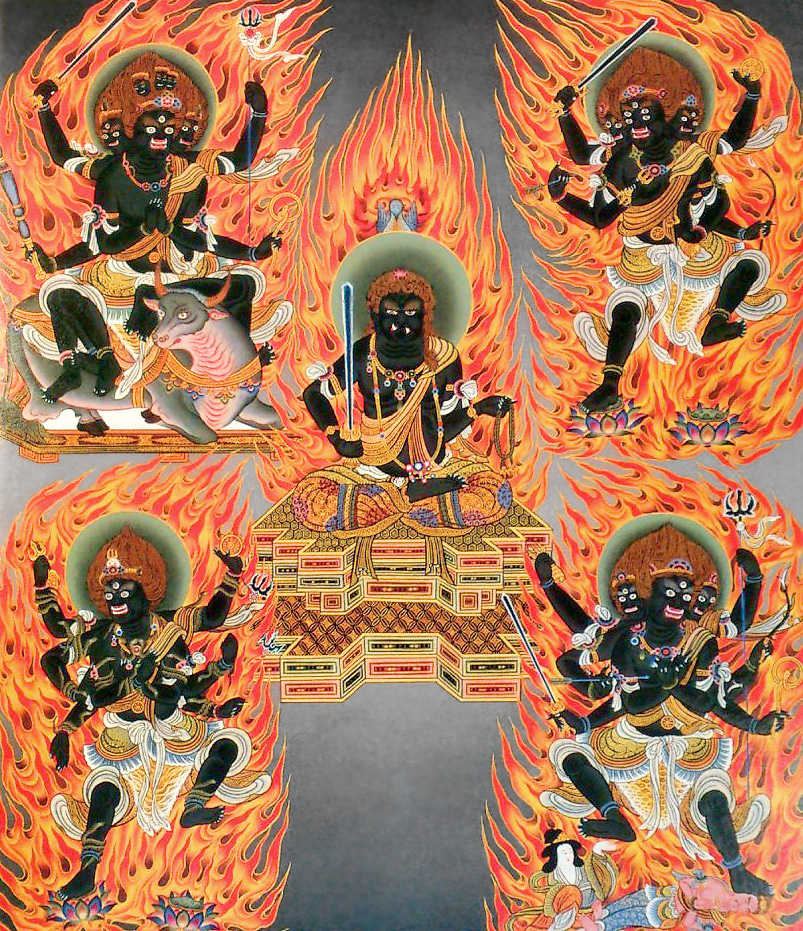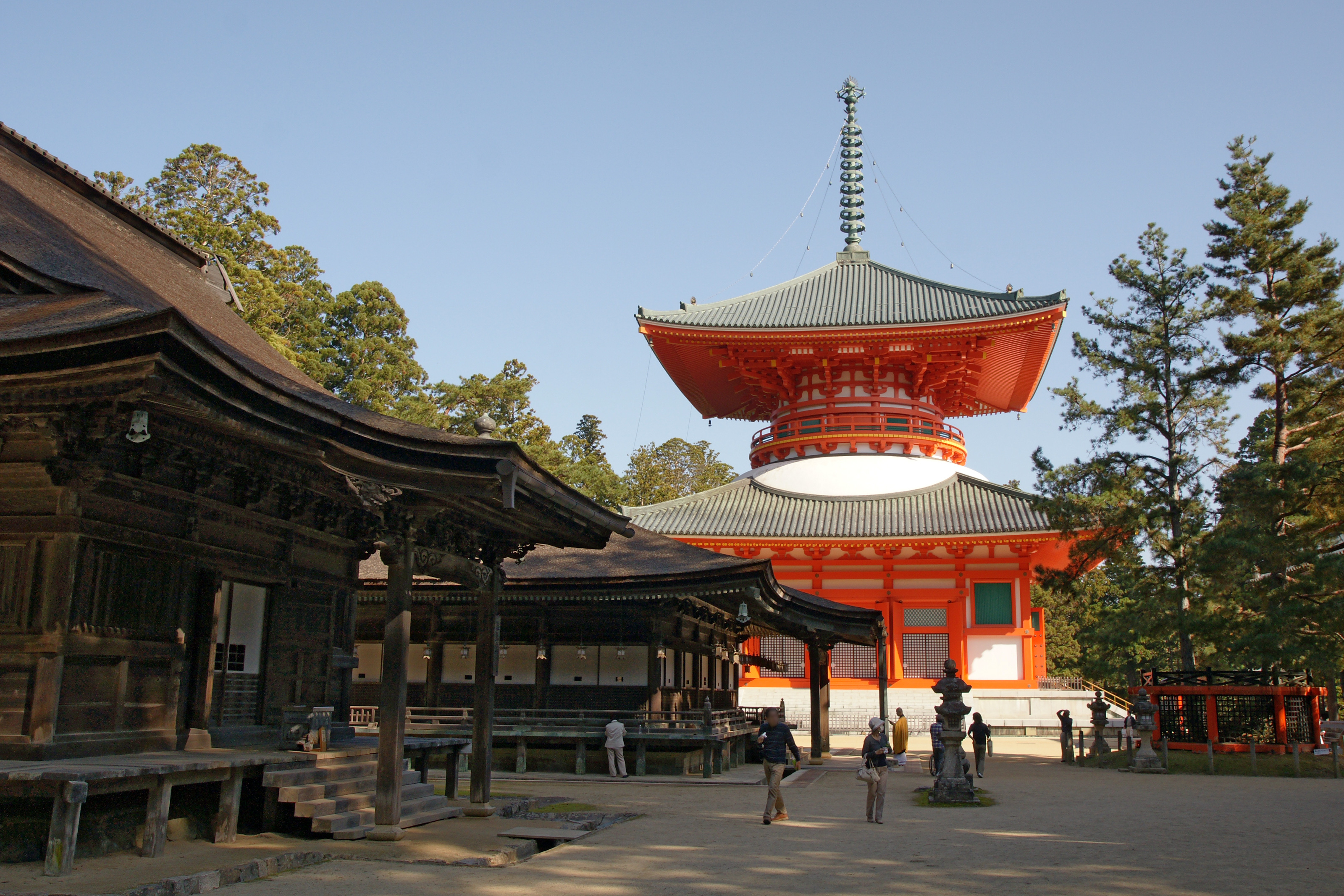|
Gozanze Myo O
Trailokyavijaya (, Japanese: ''Gōzanze Myō-ō''; Korean: ''Hangsamse Myeongwang;'' Sanskrit: त्रैलोक्यविजय) is a Buddhist wrathful deity and is considered to be a form of the bodhisattva, Vajrapani. He plays an important role in the seventh-century text, the Tattvasaṃgraha Tantra where Vajrapani takes the role of Trailokavijaya. History The worship of Trailokavijaya in China began following the transmission of various texts into the region including the Tattvasaṃgraha Tantra and the Vairocanābhisaṃbodhi Sūtra which were translated into Chinese by the monk, Amoghavajra at some point in the latter part of the eighth century. These texts were later transmitted to Japan. Iconographic representation Lord Trailokyavijaya was born from the blue syllable, Hûm. He is blue, with four faces, and eight arms. His primary face expresses a love fury, the right, wrathful compassion, disgust in the left, and behind, that of heroism. His main hands bea ... [...More Info...] [...Related Items...] OR: [Wikipedia] [Google] [Baidu] |
Amoghavajra
Amoghavajra ( ; , 705–774) was a prolific translator who became one of the most politically powerful Buddhist monks in Chinese history and is acknowledged as one of the Patriarchs of Chinese Esoteric Buddhism and Shingon Buddhism. Life There are differing views as to where Amoghavajra's origins were from. Zhao Qian states that Amoghavajra was born in Samarkand of an Indian merchant or Brahmin father as according to Feixis's Stele Inscription and a mother of Sogdian origin. Yan Ying referred to Amoghavajra simply as being "a person of the Western Regions". Alternatively, Quan Deyu's image hall stele inscription states that Amoghavajra was from Sri Lanka. Yuanzhao also repeats the claim that Amoghavajra was from Sri Lanka. Amoghavajra went to China at age ten after his father's death. In 719, he was ordained into the sangha by Vajrabodhi and became his disciple. After all foreign monks were expelled from China in 741, he and some associates went on a pilgrimage to gather te ... [...More Info...] [...Related Items...] OR: [Wikipedia] [Google] [Baidu] |
Buddhist Mythology
The Buddhist traditions have created and maintained a vast body of mythological literature. The central myth of Buddhism revolves around the purported events of the life of the Buddha. This is told in relatively realistic terms in the earliest texts, and was soon elaborated into a complex literary mythology. The chief motif of this story, and the most distinctive feature of Buddhist myth, is the Buddha's renunciation: leaving his home and family for a spiritual quest. Alongside this central myth, the traditions contain large numbers of smaller stories, which are usually supposed to convey an ethical or Buddhist teaching. These include the popular Jātakas, folk tales or legends believed to be past lives of Gautama Buddha. Since these are regarded as episodes in the life of the Buddha, they are treated here as “myth”, rather than distinguishing between myth, legend, and folk-tale. Buddhist mythology is maintained in texts, but these have always existed alongside oral ... [...More Info...] [...Related Items...] OR: [Wikipedia] [Google] [Baidu] |
Vidyaraja
A wisdom king (Sanskrit: विद्याराज; IAST: ''vidyārāja'', ) is a type of wrathful deity in East Asian Buddhism. Whereas the Sanskrit name is translated literally as "wisdom / knowledge king(s)," the term '' vidyā'' in Vajrayana Buddhism is also specifically used to denote mantras; the term may thus also be rendered "mantra king(s)." ''Vidyā'' is translated in Chinese with the character 明 (lit. "bright, radiant", figuratively "knowledge(able), wisdom, wise"), leading to a wide array of alternative translations such as "bright king(s)" or "radiant king(s)". A similar category of fierce deities known as herukas are found in Tibetan Buddhism. The female counterparts of wisdom kings are known as wisdom queens (Sanskrit (IAST): ''vidyārājñī'', Chinese: 明妃, ''Míngfēi'', Japanese: ''Myōhi''). Overview Development ''Vidyārājas'', as their name suggests, are originally conceived of as the guardians and personifications of esoteric wisdom (''vidyā'') ... [...More Info...] [...Related Items...] OR: [Wikipedia] [Google] [Baidu] |
Shingon
is one of the major schools of Buddhism in Japan and one of the few surviving Vajrayana lineages in East Asian Buddhism. It is a form of Japanese Esoteric Buddhism and is sometimes called "Tōmitsu" (東密 lit. "Esoteric [Buddhism] of Tō-ji"). The word ''shingon'' is the Kan-on, Japanese reading of the Traditional Chinese characters, Chinese word ('), which is the translation of the Sanskrit word mantra. The Chinese Esoteric Buddhism, Zhēnyán lineage was founded in China (c. 7th–8th centuries) by Indian Vajracharya, vajrācāryas (esoteric masters) like Śubhakarasiṃha, Vajrabodhi and Amoghavajra. These esoteric teachings would later flourish in Japan under the auspices of a Buddhist monk named Kūkai (, 774–835), who traveled to Tang dynasty, Tang China and received these esoteric transmissions from a Chinese master named Huiguo (746–805). Kūkai established his tradition at Mount Kōya (in Wakayama Prefecture), which remains the central pilgrimage center of Sh ... [...More Info...] [...Related Items...] OR: [Wikipedia] [Google] [Baidu] |
Chinese Esoteric Buddhism
Chinese Esoteric Buddhism refers to traditions of Tantra and Vajrayana, Esoteric Buddhism that have flourished among the Chinese people. The Tantric masters Śubhakarasiṃha, Vajrabodhi and Amoghavajra, established the Esoteric Buddhist ''Zhenyan'' (, "true word", "mantra") tradition from 716 to 720 during the reign of Emperor Xuanzong of Tang. It employed mandalas, mantras, mudras, abhisheka, abhiṣekas, and deity yoga. The Zhenyan tradition was transported to Japan as Tendai and Shingon Buddhism by Saichō and Kūkai, as well as influencing Korean Buddhism and Vietnamese Buddhism. The Song dynasty (960–1279) saw a second diffusion of Esoteric texts. Esoteric Buddhist practices continued to have an influence into the late imperial period and Tibetan Buddhism was also influential during the Yuan dynasty period and beyond. In the Ming dynasty (1368–1644) through to the modern period, esoteric practices and teachings became absorbed and merged with the other Chinese Buddhist tradi ... [...More Info...] [...Related Items...] OR: [Wikipedia] [Google] [Baidu] |
Chakram
The chakram (; ) is a throwing weapon from the Indian subcontinent. It is circular with a sharpened outer edge and a diameter of . It is also known as ''chalikar'' meaning "circle", and was sometimes referred to in English writings as a "war- quoit". The chakram is primarily a throwing weapon, but can also be used hand-to-hand. A smaller variant called ''chakri'' is worn on the wrist. A related weapon is the ''chakri dong'', a bamboo staff with a ''chakri'' attached at one end. History The earliest references to the chakram come from the fifth century BC Indian epics ''Mahabharata'' and ''Ramayana'', where the Sudarshana Chakra is the weapon of the god Vishnu. Contemporaneous Tamil poems from the second century BC record it as ''thikiri'' (திகிரி). ''Chakra-dhāri'' ("chakram-wielder" or "disc-bearer") is a name for Krishna. The chakram was later used extensively by the Sikhs at least until the days of Ranjit Singh. Even in present days, the Nihangs wear chakkar on ... [...More Info...] [...Related Items...] OR: [Wikipedia] [Google] [Baidu] |
Japan
Japan is an island country in East Asia. Located in the Pacific Ocean off the northeast coast of the Asia, Asian mainland, it is bordered on the west by the Sea of Japan and extends from the Sea of Okhotsk in the north to the East China Sea in the south. The Japanese archipelago consists of four major islands—Hokkaido, Honshu, Shikoku, and Kyushu—and List of islands of Japan, thousands of smaller islands, covering . Japan has a population of over 123 million as of 2025, making it the List of countries and dependencies by population, eleventh-most populous country. The capital of Japan and List of cities in Japan, its largest city is Tokyo; the Greater Tokyo Area is the List of largest cities, largest metropolitan area in the world, with more than 37 million inhabitants as of 2024. Japan is divided into 47 Prefectures of Japan, administrative prefectures and List of regions of Japan, eight traditional regions. About three-quarters of Geography of Japan, the countr ... [...More Info...] [...Related Items...] OR: [Wikipedia] [Google] [Baidu] |
Vairocanābhisaṃbodhi Sūtra
The ''Vairocanābhisaṃbodhi Sūtra'' (''Vairocana, Vairocana’s Awakening Sutra'', ), also known as the ''Mahāvairocana Tantra'' (; ; also known as 大日經 :zh-tw:大日經, ''Da Ri Jing'') is an important Vajrayana Buddhist text composed before 674 CE.Silk, Jonathan A. (editor) ''Brill’s Encyclopedia of Buddhism Volume I: Literature and Languages,'' p. 382. The Indian tantric master Buddhaguhya (Floruit, fl. c.700 CE) classified the text as a caryātantra, and in Tibetan Buddhism it is still considered to be a member of the Classes of Tantra in Tibetan Buddhism, carya classification. In Japan where it is known as the ''Mahāvairocana Sūtra'' (''Daibirushana jōbutsu jinpen kajikyō)'', it is one of two central texts in the Shingon school, along with the ''Vajrasekhara Sutra''. Both are also part of the Tendai school. Though the text is often called a Buddhist Tantras, tantra by later figures (including later Indian commentators), the scripture does not call itself a tan ... [...More Info...] [...Related Items...] OR: [Wikipedia] [Google] [Baidu] |
China
China, officially the People's Republic of China (PRC), is a country in East Asia. With population of China, a population exceeding 1.4 billion, it is the list of countries by population (United Nations), second-most populous country after India, representing 17.4% of the world population. China spans the equivalent of five time zones and Borders of China, borders fourteen countries by land across an area of nearly , making it the list of countries and dependencies by area, third-largest country by land area. The country is divided into 33 Province-level divisions of China, province-level divisions: 22 provinces of China, provinces, 5 autonomous regions of China, autonomous regions, 4 direct-administered municipalities of China, municipalities, and 2 semi-autonomous special administrative regions. Beijing is the country's capital, while Shanghai is List of cities in China by population, its most populous city by urban area and largest financial center. Considered one of six ... [...More Info...] [...Related Items...] OR: [Wikipedia] [Google] [Baidu] |
Tattvasaṃgraha Tantra
The ''Sarvatathāgatatattvasaṃgraha sutra'' (Sanskrit, ''Compendium of the Reality of All Tathāgatas''), also known as the ''Tattvasaṃgraha Tantra'', is an important seventh century Indian Buddhist tantric text.Silk, Jonathan A. (editor) ''Brill’s Encyclopedia of Buddhism Volume I: Literature and Languages,'' p. 373. Although the scripture refers itself as a Mahayana sutra, the content is mainly tantric in nature and thus is sometimes called a tantra. This work is an important source for the Chinese Esoteric Buddhist and Shingon tradition. This text was very important for the development of the Vajrayana Yoga tantra traditions in India, Tibet, China, Japan and Sumatra, amongst others. The ''Tattvasaṃgraha'' is extant in Sanskrit, Tibetan and Chinese. Weinberger (2003: p. 4) holds: The ''Compendium of Principles'' marks the emergence of mature Indian Buddhist tantra at the end of the seventh century, and it immediately spawned a body of literary progeny that has ... [...More Info...] [...Related Items...] OR: [Wikipedia] [Google] [Baidu] |





